Note: This is a spoiler-lite review. If you want a spoiler-heavy in-depth look at the film, click here.
Towards the climax of Star Trek: Into Darkness, Kirk and the Enterprise flee an aggressor by entering warp. At that speed, several factors the speed of light itself, they surmise that they must be safe from their pursuer. Of course, they prove to be wrong – brutally so. Everything in Into Darkness moves fast, so fast that the Enterprise’s top speed seems more like a casual jog than a breakneck acceleration. The plot rockets along with incredible speed, from plot point to plot point, counting on the momentum to sustain the film and carry it across the line.
There is enough material here to produce a trilogy of films. Indeed, cynics might suggest that a lot of the movie’s iconography and plot points are indeed recycled from the central “trilogy” of the original Star Trek films, running from the homages to Star Trek II: The Wrath of Khan right down a climactic visual reference to Star Trek IV: The Voyage Home. Abrams and his team of writer continue their work from 2009’s breakout blockbuster Star Trek by putting the franchise’s most compelling images and cues into a high-speed blender.
Into Darkness just substantially increases the concentration.
Put simply, Into Darkness feels more “Trekkian” – for lack of a better word – than its direct predecessor. It feels more firmly anchored in the lore and philosophy of the sixties television show and its 700+ episodes of spin-offs and tie-ins than the 2009 Star Trek reboot was. While this film’s predecessor felt like a very clean break from the forty-odd years of history built up since William Shatner and Leonard Nimoy first appeared on screen, Into Darkness feels more firmly anchored the show and its own history.
Jaded commentators will argue that the connection is a cynical attempt to play on familiar images and characters. Much debate, for example, has raged over the identity of the movie’s villain. Crazy theories about the real identity of “John Harrison” have flooded the internet since Benedict Cumberbatch assumed the role. I won’t spoil it here, but I will concede that while his origins and back story provide a strong tie to the show’s classic continuity, Harrison has very little to do with Into Darkness‘ connections to its franchise roots. He is, to quote Harrison himself, “a smokescreen” – a distraction and a decoy.
Instead, Into Darkness makes a very conscious effort to connect the franchise’s long and distinguished history of social commentary. In its heyday, Star Trek was a vehicle for raising big questions and for pushing the envelope in ways that many contemporary television drama either would not or could not do. Stories like Errand of Mercy and A Taste of Armageddon offered a condemnation of the Cold War mentality. Plato’s Stepchildren featured one of the very first interracial kisses on prime time network television.
It’s a long and distinguished tradition for the franchise, and even extended to the spin-offs. Star Trek: Deep Space Nine even managed to offer a thoughtful exploration of the war on terror before the term was popularly used. In a manner that might seem heavy-handed but for the fact that it aired in the nineties, the franchise’s oft-overlooked live action spin-off explored the lengths that humanity would go to in order to protect their utopia.
Perhaps appropriately, then, there’s quite a lot of that to be found in Into Darkness. JJ Abrams’ two films rather wisely pick and chose from the most memorable or distinguished imagery in the show’s extended history. The uniforms are the bright primary colours seem in the sixties, airing on a show produced by a network to convince viewers to invest in colour televisions manufactured by its parent company. However, the movie borrows iconography from all eras of the franchise, reaching into the collective popular unconsciousness to formulate a version of Star Trek distilled for casual movie-goers.
The film’s climax borrows heavily from The Wrath of Khan. Spock even recites his catchphrase from the film. (“The needs of the many…”) However, the Enterprise also plummets to Earth in a sequence designed to evoke the most iconic moments from Star Trek III: The Search For Spock. A hijacked ship plunges into San Francisco Bay, as it did at the climax of The Voyage Home. McCoy even appears to have a pet tribble.
However, Abrams and his team wisely realise that they have a much larger pool to mine. References to Deep Space Nine‘s shadowy “Section 31” work their way into the script, suggesting a rather cynical view of the United Federation of Planets. Kirk finds himself racing what should be a friendly ship back to Earth in a moment which feels like an homage the same show’s Paradise Lost, as he finds himself wrestling with questions of liberty and security.
Warrior aliens attacking Kirk and his away team on a distant war-world use weapons very clearly designed to evoke the Klingon Bat’leth as familiar to even casual viewers of The Next Generation. The villain’s plan for a “more militarised Starfleet” recalls several familiar Star Trek plot lines and episodes, especially that aforementioned Deep Space Nine story arc.
On some level, this is occasionally frustrating. It feels like – at points – Abrams and his writers are simply breaking down the show’s iconography and recycling the “best of” moments using superior special effects and much more impressive budget. There’s even a completely superfluous late cameo which feels rather unnecessarily self-referential. That said, there is some reason to it. These images endure because they are iconic, and Abrams is presenting them to an audience who would be mostly unfamiliar with their origins.
As with its predecessor, one of the most remarkable skills of Into Darkness is an uncanny ability to take a franchise that had been niche and geeky, and to make it fit for mass consumption. To recognise the value in these original set pieces and images, and to realise that they can be skilfully incorporated into a film which appeals beyond a core demographic. I’ve never understood how any Star Trek fan could resent that. Even the most jaded old-school aficionado should appreciate that Abrams is sharing something very wonderful with a broad audience.
However, this use of imagery and these internal references aren’t what makes Into Darkness feel so closely connected with the show that spawned it. It’s the way that Into Darkness tries to engage with modern political ideas, and dares to thread some social and moral commentary into its impressive tapestry. Given the realities of commercial film-making, Star Trek has always handled these issues better on the small screen. The most political that the film franchise ever got was with the fourth instalment, which wholeheartedly embraced the hardly controversial “save the whales” eco-politics of the eighties.
Into Darkness doesn’t always tackle its political subtext gracefully. It’s often quite clumsy, as Harrison makes grandiose statements about “an uncivilised threat in a civilised world.” The high watermark for political commentary inside a commercial blockbuster remains The Dark Knight and the rest of Nolan’s Batman films. However, it is nice that Into Darkness makes the effort to be more than just a loud summer blockbuster.
More than that, though, it ties in quite well with its direct predecessor. 2009’s Star Trek was essentially a blockbuster for the Obama generation. It makes sense, given the links between the original Star Trek and Kennedy’s Camelot, and the attempts made to compare Obama to Kennedy. Abrams’ original Star Trek might not have had the strongest political commentary, but it did have a very optimistic core. Star Trek was a bright ode to optimism, cast in whites and primary colours, standing in contrast to the dour and greyed out colour schemes of most contemporary blockbusters.
Despite its title Into Darkness retains that optimism, and very strongly embraces the liberal philosophy upon which the classic show was based. As the name implies, there are hints of cynicism here, a sense of darkness and ambiguity creeping in around the edge. The movie features an early suicide bombing in a major metropolitan hub, which turns out to be a ruse so a second (more brutal) assault can be mounted by the terrorist mastermind.
Kirk is assigned a mission of vengeance to hunt down a terrorist. When he finds John Harrison, he is instructed to kill the murderer, using long-range torpedoes launched into enemy territory, recalling drone strikes. Harrison will be summarily executed, without trial. The climax features a craft piloted directly into skyscrapers in an attempt to cause as much suffering and damage as possible. It is hardly subtle.
However, Into Darkness only uses this premise to rail against. It doesn’t embrace cynicism, it challenges it in a way that would make its televisual roots quite proud. “Is that what we are now?” Scotty demands as the military weapons are loaded on board. “Because I thought we were explorers.” Throughout Into Darkness, the optimism of the Starfleet crew is continually reaffirmed against all the darkness the universe can offer. Cornered and watched by enemy guns, Kirk considers a suicidal last stand with his phaser. Uhura offers an alternative. “You brought me here because I could speak Klingon. Let me speak Klingon.” Let’s talk it out.
Towards the end of the film, humbled by all that has been lost, the captain of the Enterprise reflects on “the captain’s oath.” It’s a solemn vow taken by Starfleet commanders. You should know it already. Discussing this oath, reflecting on all that has been lost, the captain of the Federation flagship observes, “I see it as a call to remember who we once were and who we must be again.” It feels like Abrams is effectively reinforcing the optimism of Star Trek, suggesting that holding it up against the darkness of the world makes the show’s optimism more valuable (and more worth protecting) than ever.
Outside of the firmer connection to the movie’s roots, Abrams and his writers bring back a lot of what made their first adventure so compelling. Like 2009’s Star Trek, Into Darkness is mostly driven by character beats, with the primary cast each given something to do. It’s worth noting that Abrams continues to develop the peripheral cast much better than any of the original Star Trek television show (or even the films) really did.
Although this is still very much the Kirk and Spock show, Scotty, Uhura and Bones all get a decent amount to do. Indeed, it seems like Bones has been edged out of the franchise’s “trinity” a bit, replaced by Uhura, perhaps an acknowledgement by JJ Abrams that mainstream cinema needs more well-developed female roles. That probably also accounts for the introduction of Carol Marcus, played by Alice Eve. However, despite the welcome addition of another significant female cast member, Marcus’ arrival overcrowds the film quite a bit, not helped by the fact that Eve is the weakest member of the ensemble.
Still, the focus is on Kirk and Spock, and it’s here that Into Darkness feels a little rushed and a little too compressed. The opening half-hour sets the two at odds in a way that seems logical and makes a great deal of sense, but it gets brushed aside rather quickly. Kirk and Spock could both actually use more room to breathe in the film, and to develop as characters. The conflict between the two is interesting, but is almost fleeting. It’s a shame, because that conflict was one of the best aspects of the first film.
There are lots of nice little touches. I like, for example, the acknowledgement of the Spock and Kirk bromance. At one point, Kirk and Uhura sympathise over how tough it can be to get along with Spock. “Are you two fighting?” Kirk asks. “What is that even like?” Uhura doesn’t respond that he probably has a very good idea of what it’s like to have a relationship breakdown with Spock, but the film hints in that direction.
Certainly, it seems like the only thing that could possibly overwhelm Spock’s emotional control is a threat to Jim. “You can’t even break rules,” Harrison taunts at one point. “How could you be expected to break bones?” Naturally, when Harrison threatens Kirk, he finds out what happens when you push Spock’s buttons too hard. That is, as you might expect, bad news for him.
Into Darkness is great fun. It is a bit rushed in places, and it does lean a bit too heavily on nods and references to previous films and adventures. However, it’s fun and fast-paced and it represents an attempt to engage with modern political and social issues, making a considered defence of the franchise’s trademark optimism. It’s hard to resist that.
Filed under: Non-Review Reviews | Tagged: Benedict Cumberbatch, chris pine, Darkness, J Abrams, J. J. Abrams, james t. kirk, kirk, Leonard Nimoy, spock, star trek, Star Trek II: The Wrath of Khan, Star Trek III: The Search For Spock, Star Trek Into Darkness, star trek iv the voyage home, star trek: enterprise, Star Trek: The Motion Picture, star trek: the original series, StarTrek, Taste of Armageddon, twitter, United Federation of Planets, William Shatner |















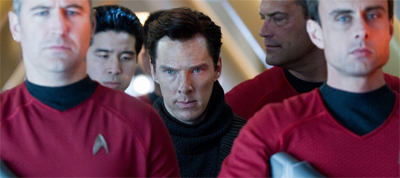
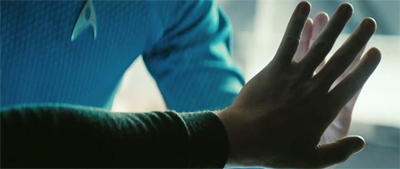




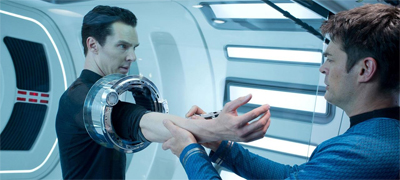

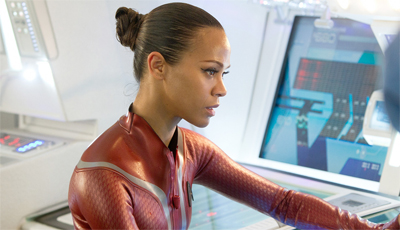
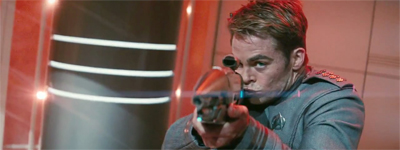
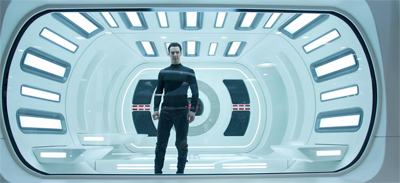
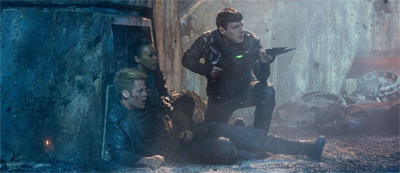





Your non-reviews are always some of my favorite posts that you make. I truly dug the Iron Man 3 non-review review, and this is no exception. WONDERFUL! I can’t wait to see it.
Glad you enjoyed the review and hope you enjoyed the film. Pop back tomorrow or Staruday for a more spoiler-ladden in-depth look at the film, sort of in keeping with my other Star Trek posts this month.
He’s in a glass case of emotion… haha xD
Anchorman references are always worth a laugh! 🙂
Just saw the film and loved it, good stuff 😀
Glad to hear it!
I found the film underwhelming and a let down when it comes to storytelling and fleshing out the characters. The main scene of Wrath of Khan doesn’t function here at all, because the two guys doing the scene aren’t buddies yet and no emotion is evoked. I almost laughed at this scene, as this was so out of context that I thought this almost ruins the film.
This film consist mostly of running people, big bangs, hitting people, fast pasted action and a no braner for the story itself. It can’t sympasize with the new crew because they still have no family bound, no caring for each other resulting of context they share. Why is Kirk a captain I asked mayself over and over. What did he do to earn it. Kirk and Spock as a duo doesn’t function as they have known each other only for one film only. Lethal Weapon could produce such a bonding better than this new Trek film. There is so much wrong with this film, I can’t even think of were to start.
Anyhow, I give this new Trek one more chance, before I decide to stop watching the new films.
I have 2 opposite reactions to your review. Both equally true and relevant. The first is simple. You didn’t like the film. We all do and should respond to things as we truelly feel.. The other response is that I think you are wrong and missed alot in that film. Clearly, as I am writing here, I have chosen to counter your opinion.
‘ Kirk and Spock as a duo doesn’t function as they have known each other only for one film only’
Well clearly that is specifically correct as far as the films are concerned but not only was that the first film wher ethe characters meet a very intense one it would have forced an early appraisal by the characters of each other. However as characters between the films, time and living together has given them some experiance of living and working together.
But most important is the fact is that the POINT of this film is that crew get to know and rely more on each other and thus become the friends and character we did see in T.O.S. At the beginning of the film they are NOT there yet and that’s the point of them becoming more of that during the film. Getting to know each other rather than just meeting each other, as in the first film.
‘This film consist mostly of running people, big bangs, hitting people, fast pasted action and a no braner for the story itself.’
Well I’ll just ask you to reread the article itself; as it explains this very well although I would consider the importance of the moral questions facing Kirk and the rest of his crew are precisely the meat of the motivations both in this film and indeed in T.O.S.! That is the soul of Star Trek if you liken Something you don’t even touch on in your comments.
I actually think, at the risk of being controversial, that Abrams’ films are more character driven than most of the Original Series. With the exception of Spock, most of the cast were fairly one-dimensional, defined by their actors. I’d argue that Kirk didn’t really become a functioning three-dimensional human being (more than merely an archetype) until The Motion Picture.
I think it’s fair to argue that The Wrath of Khan built on ideas only really identified in The Motion Picture. In a way, Khan’s vengeance is poetic justice. Kirk arrogantly hijacked the Enterprise from another commander in both films, in order to satisfy his ego. The Wrath of Khan called him on it, but The Motion Picture let him off the hook. (“Hm, the man who would be captain ascended to a higher plain. I guess you’re in charge now, Jim.”)
I think the character beats in The Wrath of Khan are stronger than Into Darkness, for reasons I go into in the spoiler review. Most obviously, Kirk gets off the hook here. It’s not humbling to sacrifice yourself to save the crew. It’s humbling to watch your oldest friend sacrifice himself because of your arrogance. (And then to lose your son as an indirect consequence.)
Still, I think that the cast here have a great rapport. Do I think they are as tight as the Next Generation cast or that of Deep Space Nine? Not even close. Do they feel more organically connected than the casts of Voyager or Enterprise? Definitely. Are they about (roughly) where the Original Series cast were two films into their big screen adventures? If not, I’d say they’re close.
Then again, I think that The Search for Spock is the best use of the original cast as an honest-to-goodness ensemble. (With The Voyage Home almost as good.)
In response to your quote: ” the captain of the Federation flagship observes, “I see it as a call to remember who we once were and who we must be again.”
I have written on that with Lincoln, Zero Dark Thirty and Jackson’t essay on Thucydides History of the Peloponnesian War where he addresses that abrupt change that takes place in Athens.
http://moviesandfilm.blogspot.com/2013/03/lincoln-and-zero-dark-thirty-cracking.html
Thanks for the link and the thoughts. Hadn’t really contextualised it in the grand scheme of history, but I do think that there are hints of mainstream American cinema trying to come to terms with how things have changed in the years since 9/11. It has taken a while, but I think that the distance was necessary. (Of course, we had issue-based films on the War on Terror before, but I always felt that Rendition or Syriana were too close to offer any real insight beyond familiar rhetoric.)